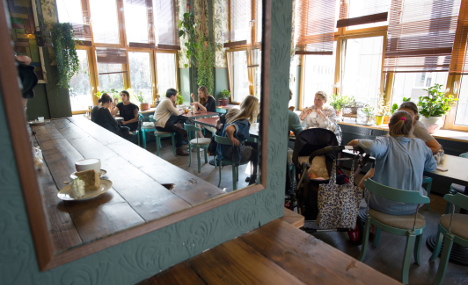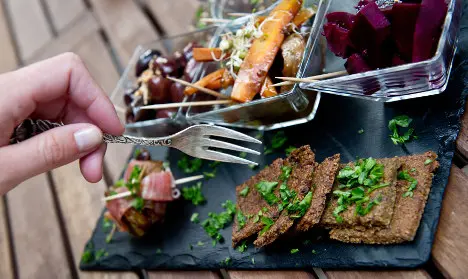It's one thing to tour a city's landmarks, museums and gift shops. But sampling its culinary offerings can sometimes tell you more about its lesser known history and shifting dynamics.
On a recent drizzly Friday afternoon, I followed a cobblestone pavement through the graffitied facades of Berlin’s Neukölln district to my destination at a small square, consisting mainly of a public toilet and food stand selling cheap fries and sausages.
It’s not exactly the first place you’d expect to meet a food tour offering a rich culinary experience in a major European metropolis, but that’s perhaps what makes it perfectly Berlin.
Food tours here are not aimed so much at Michelin-star-gazers, but towards the more open-minded of tourists, eager to explore offbeat neighbourhoods, as well as for locals looking to discover their own.
As international gastronomy rankings attest, Germany - let alone its capital - is not known for its fine dining experience in the same way that France or even Germany’s northern neighbour of Denmark are. Copenhagen, for example, was home to
three of the world’s best restaurants rated in 2016, whereas Berlin had just one.
And while Paris currently has ten three Michelin-star establishments,
Berlin has none.
But Berlin’s growing food scene is nevertheless the topic of numerous German- and English-language blogs, books and specialized food tours - and they're not just aimed at showcasing the city’s typical döner kebab and currywurst.
“Most people never eat at a restaurant with Michelin stars. To the average person they want a good meal at a good value, and Berlin provides that in spades,” Karl Wilder of Secret Food Tours explained.
“Because of our lower operating costs, chefs can also experiment and deliver excitement. It does not matter if the critics take notice. The customers take notice. I think the perspective has already changed, and people see Berlin as past it's infancy for food tourism.”
 House of Small Wonder in Berlin. Photo: DPA
House of Small Wonder in Berlin. Photo: DPA
Over the past decade, a number of food tours like Wilder’s have cropped up in the capital, often in neighbourhoods outside the city centre and off the radar of most sightseers, like the eat-the-world tour I dropped into in Neukölln.
You can also visit the former East German avant garde district of Friedrichshain with Secret Food Tours, get to know the former punk hub of Kreuzberg with eat-the-world, or even wander the streets of ‘up-and-coming’ Moabit with Berlin Food Tour - a central yet still fairly residential neighbourhood that the tour group describes as a “hidden gem”.
Our Neukölln tour was focused on an even lesser known part of the neighbourhood which already scarcely sees out-of-towners: Rixdorf. A major goal of these tours is not just to expose participants to new eateries, but also to new aspects of the city’s history and its connection to how people eat.
“After the war, there was no money in Berlin and people had to be really inventive about food, about everything,” my eat-the-world guide Adrian Castillo told me.
Wilder, a food historian, also explained that the impact of two World Wars in Berlin shaped the city’s culinary scene in a different way than other capitals, limiting its resources.
“It did not evolve in the same way as others cities and thus many unique foods are to be found.”
Neukölln’s culinary scene is very much shaped as well by the district’s history of immigration. Rixdorf is now spotted with cool new cafes, housed along streets and in buildings once part of a village used as a haven for Czech Bohemian Protestant refugees in the 1700s. In the 20th century, Neukölln became known for its sizable Turkish population, many of whom came through a guest worker programme in the 1960s.
But now, with its cheap rents and hip bars, the neighbourhood is also attracting gentrifying hipsters, particularly from English-speaking countries.
This mix of cultures was apparent in the selection of stops along the food tour: a cafe called Zuckerbaby run by two German-American sisters and recent Berlin transplants; a vegan cafe and co-working space with the French name of Pêle-Mêle; and a modern Arabic kitchen with an English name: OS’Kitchen.
Neukölln alone now seems to have a new hyper buzz-worthy bistro popping up right, left and centre: a vegan “diner” opening along the district’s busy Karl-Marx-Strasse in April caused such a
frenzy of hungry hipsters that police were called in to clear the crowds just 20 minutes after it had opened its doors.
So the booming food scene in the neighbourhood and in others also reflects the changing nature and gentrification of the city, especially since the fall of the Berlin Wall.
“Fifteen years ago, a friend of mine told me that she found a new flat and she said ‘unfortunately it’s in this very ugly district called Neukölln’. Nobody would say that today. Nobody,” Castillo told me with a chuckle.
Food tours can therefore give tourists a taste of the ongoing transformation, providing a launch pad for districts in flux to gain more name recognition.
But they’re also a gateway for locals into parts of their own city that they might not even know about, like for fellow eat-the-world tour-taker Holly Krueger, a recent American immigrant to Berlin.
“I live in Berlin and I was really surprised. You’re thinking a Berlin food tour means just currywurst, but then this is here,” Krueger told me, gesturing around her as we sat at Asian-soul-food bistro Coco Liebe, founded by a Lebanese chef.
“There’s a culinary tradition here that’s not so obvious.”
 House of Small Wonder in Berlin. Photo: DPA
House of Small Wonder in Berlin. Photo: DPA
Comments